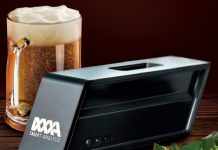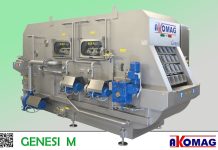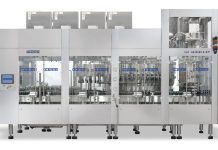
Aseptic packaging offers a natural and safe product to consumers and cost savings in terms of energy consumption and packaging materials to the producers
In the last decade the field of beverage and mineral water bottling has recorded important developments that have enabled the realization of filling lines for non-carbonated beverages and similar products without the use of preservatives or final pasteurization. The first applications were made by packaging companies of mineral water with the purpose of ensuring product quality in non-carbonated water bottling, which presented serious problems of mold contamination in the finished product. Prior to filling, these bottles were generally sanitized with ozonated water or similar, rinsed and then filled. At each production stop, the filling lines were cleaned externally through antibacterial foaming, and internally by the passage of washing and sanitizing solutions such as those based on hot caustic soda. Unfortunately, due to the system type, recontamination of the product could not be excluded. The caps were another source of contamination, as they were used without prior sanitization.
Aseptic filling today
Currently the aseptic filling technology ensures the production of hygienically safe beverages with long shelf life. A modern line of aseptic filling is essentially composed by: a sterilization system for containers and caps/capsules; a filling machine able to fill and cap the containers under aseptic conditions; a control system for environmental contamination; an overall supervisory system able to monitor and record typical parameters, correct operation conditions and alarms. The heart of this production process is a mono-block machine formed by 3 in line units devoted to 3 production steps: sterilization of empty bottles, rinsing of sterilized bottles and bottle filling and final capping. Functionally a mono-block filling is characterized by a continuous flow of bottles, moved by belts that pass from one production phase to another. The productive typology has also the need of facilitating small maintenance interventions on the machines. Currently the choice is a mixed-type isolation system with use of physical and dynamic barriers that could isolate the internal controlled environment against the surrounding environment. Innovation in the supervisory systems allows controlling the whole line from a single operator panel or from a remote location, reducing potential risks identification times and the reaction times to bring back the line in optimal operating conditions. The operator is assisted by increasingly sophisticated software, which reduces the margin for error and is able to predict the onset of potential risk situations, suggesting the suitable countermeasures. If these risks aren’t identified in real time, big volumes of product may be affected, considering the high production rates of current filling lines, which often exceed 30,000 bottles/hour. Recently, compact aseptic fillers have been put on the market to enable medium-level companies to work in aseptic small batches with economic benefits. PET aseptic filling in a compact aseptic system facilitates the transition from compact aseptic cartons to PET, which is more appreciated by consumers, and allows also direct access of sensitive beverages in PET bottling without preservatives.

Peracetic acid or gaseous hydrogen peroxide
Some machines are washed with acid and/or basic detergents, thus making superfluous the use of peracetic acid and foaming detergents. Sterilization of packaging materials (caps and containers) can be done with hydrogen peroxide or peracetic acid. The first solution has some advantages compared to peracetic acid, even if sports-cap caps of the push-pull and flip-top type are used. The use of hydrogen peroxide also involves reduced water consumption and water waste volumes. The substance can be used in the gaseous state to sterilize bottles, after heating them at 50-60°C and then sterilizing them internally with gaseous hydrogen peroxide, without internal condensation. The advantage of this type of sterilization consists in employing mild temperatures, which allow extending the action time of gaseous hydrogen peroxide without damaging the PET containers. The new aseptic filling lines, that use peracetic acid-based sterilizing solution for the sterilization of systems and containers, optimize consumption and line usage costs thanks to the recovering of peracetic acid solution and the sterilization of rinsing water by microfiltration. To avoid pauses during filling, in some machines the product can be changed without intermediate rinsing. This procedure enables filling to continue until the reservoir is empty and allows the residual amounts present in the filling valve to be bottled with the new product and then discarded. The elimination of intermediate disinfection is ideal, allowing long production runs, up to 48 hours for low-acid products and up to 72 hours for high-acid products.
Trends

The trends of aseptic filling concern filling flexibility but also format change without sterility loss for containers with the same neck diameter (handled through a “neck handling” transfer system) and filling accuracy. Alternative solutions for the use of chemicals in sterilization are being studied, such as the use of electron emitters to produce low energy electron beams that, directed on the surface of the capsules for very short processing times, guarantees a high decontamination level, or sterilization methods based on ionizing or non-ionizing radiations (high-frequency pulsed light or high-energy radiation).



